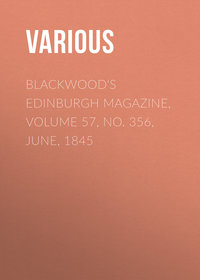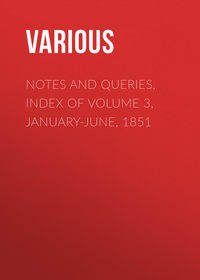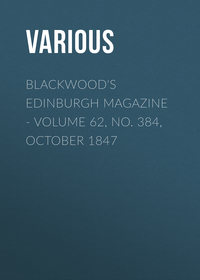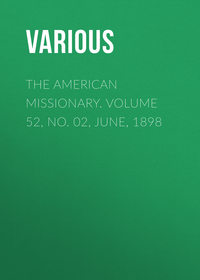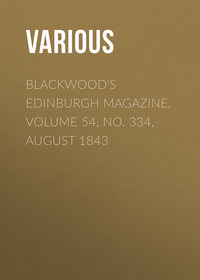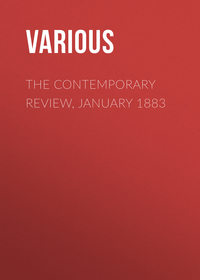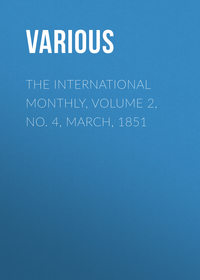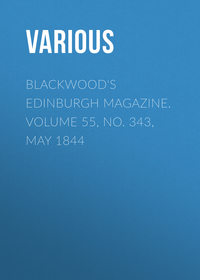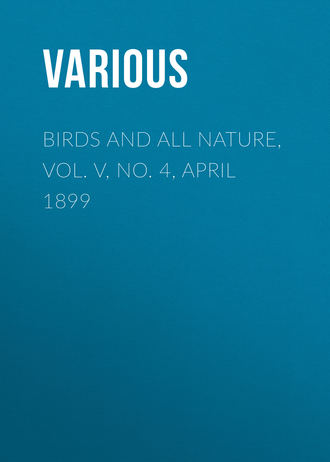 полная версия
полная версияBirds and All Nature, Vol. V, No. 4, April 1899
This owl undoubtedly breeds, though sparingly, in all suitable localities wherever it is found, and probably migrates more or less in the northern part of its range. In Europe it nests in old ruins, towers, and abutments of bridges, but our American species finds few such places, so he resorts to hollow trees, caves, crevices in rocks, and banks, and even to burrows in the level ground, as we find to be the case in parts of the West. The burrows are undoubtedly the deserted burrows of some other animal. In the eastern parts of the country the owls frequently nest in buildings. It is well known that a pair occupied one of the towers of the Smithsonian building in the city of Washington in 1890, raising a brood of seven young. It is stated that the period of incubation is from three to three and a half weeks, and that brooding begins with the deposit of the first egg; thus there may be fresh eggs and young in the same nest. This accounts for the long period of incubation.
The eggs are pure white, usually from four to seven in number, rarely twelve. They are rather longer in proportion than those of the other owls – in about the proportion of 1.30 × 1.70. But the average size is variously given by the various authors.
It seems a little curious that there should be such a marked difference between the hawks and owls as regards nest material. They belong to the same order of birds, and yet the hawks build their own nests, collecting the material and arranging it much after the fashion of higher birds, while the owls make practically no nest, at the most collecting a little material and scattering it about with little regard for arrangement. But the difficulty disappears when we realize that the owls have probably always nested in hollows which require no nest material, while the hawks, if they ever nested in hollows, have long ceased to do so, building their nests among the branches of trees, where a relatively large amount of material is necessary. The few species of hawks which now nest in hollows have gone back to that method after a long period of open nesting and have retained the nest material even here where it seems unnecessary.
The monkey-like appearance of this owl, emphasized by his tawny color and screeching voice, gives him a decidedly uncanny appearance. His plumage is unusually soft and fluffy, but is too thin to enable him to withstand the rigors of a northern winter. Curiously enough, the feathers on the back of his tarsus grow up instead of down, giving that part of his plumage a rather ungroomed appearance. One edge of his middle toe-nail is toothed like a comb.
During the nesting season only a single pair can be found in a place, but at other times the species is more or less gregarious in the regions in which it is numerous. Often a dozen individuals may be found in a company. The extreme seclusiveness of the birds during the day makes it very difficult to find them, and they are undoubtedly more numerous than generally reported, and are likely to be present in many places where their presence is not now suspected. They seek the darkest and most secluded corner possible and remain quiet all day. Their noiseless flight might easily be mistaken for that of the whippoorwill. Let us hope that the good qualities of this owl will be fully recognized before his hiding-place is discovered.
A SPRINGTIME
One knows the spring is coming;There are birds; the fields are green;There is balm in the sunlight and moonlight,A dew in the twilights between.But ever there is a silence,A rapture great and dumb,That day when the doubt is ended,And at last the spring is come.Behold the wonder, O silence!Strange as if wrought in a night, —The waited and lingering glory,The world-old fresh delight!O blossoms that hang like winter,Drifted upon the trees,O birds that sing in the blossoms,O blossom-haunting bees, —O green leaves on the branches,O shadowy dark below,O cool of the aisles of orchards,Woods that the wild flowers know, —O air of gold and perfume,Wind, breathing sweet, and sun,O sky of perfect azure —Day, Heaven and Earth in one!Let me draw near thy secret,And in thy deep heart seeHow fared, in doubt and dreaming,The spring that is come in me.For my soul is held in silence,A rapture, great and dumb, —For the mystery that lingered,The glory that is come!– W. D. Howells.THE KANGAROO
C. C. MTHE Kangaroos are regarded as among the most remarkable of mammals. Everything about them is extraordinary; their movements and their attitudes when at rest, the way they seek their food, their reproduction, their development, and their mental qualities. Twenty and thirty years ago, it is said, the visitor to Australia could see more Kangaroos to the square mile than there are jack rabbits to-day, and it was literally impossible to avoid the countless flocks that swarmed over the whole island. Walsh says that, with a good rifle, he could take a position on a rock and shoot all day long, until tired of the monotony of the slaughter, or until some "old man" kangaroo became desperate at his killing and decided to turn the table upon him. In those days men were paid liberally by the sheepowners to kill off the kangaroos, and it is stated that one hunter would kill several hundred a day, and one man is known to have cleared $4,500, free of living expenses, in a single year. The visitor to Australia to-day discovers a decided change in many ways, but not more so than in the comparative scarcity of this animal. He may reside on the island for a month or two and not see one kangaroo. There are still large numbers of them, but they must be hunted up and their favorite feeding-places located by guides. The sheepherders caused the creatures to be destroyed in such numbers before they became of any commercial value that they are now rarely found outside of the "bush." About three hundred miles back from the coast thousands can still be found. The country abounds in straggling bushes, with very few tall trees or woods to obstruct travel; but the bushes, while in the open country, are tall enough to make good hiding-places for the marsupials. They feed on the grass, roots, and leaves, and when startled by a hunter, leap over the bushes as easily as a rabbit jumps over the tufts of grass.
The hind legs of the kangaroo are powerful weapons. One long claw, hard as bone or steel, and sharp as a knife at the point, gives the kangaroo an implement, says a writer in the Scientific American, that can kill a man or beast with one blow. The front paws are not so strong, but an old fellow has strength enough in them to seize a dog and hold him under the water until dead. On land they will seize an enemy and hold him until the hind claws can cut him nearly in two. They are also good boxers, and when the natives attempt to kill them with clubs they dodge the implements with all the skill of a professional pugilist, and unless the man is an expert he may get the worst of the encounter. Quite a number of hunters have been severely injured, and some killed, by attempting to corner a wounded kangaroo when enraged by a bullet wound. The fleetest horse cannot keep pace with any of the larger kangaroos, but with a little tact the hunters are enabled to capture them whenever they are sighted. When the creatures are once started on a run, they will not swerve from their course, but continue straight onward, leaping over bushes, rocks, and all ordinary obstacles. The hunters generally station themselves in the line that the animals are most likely to pursue, and then wait until the dogs or the rest of the party start them up.
The ordinary gait of the kangaroo, which it assumes principally when grazing, is a heavy, awkward hobble. It supports its fore feet on the ground and then pushes the hinder legs on between them. While doing so it must also support itself on its tail, as else it could not lift its long hinder legs high enough to render such movements possible. But it remains in this position no longer than is absolutely necessary. Whenever it has plucked some favorite plant, it assumes the erect position to consume it. In their sleep the smaller species adopt a position similar to that of a hare in its form. Closely crouched to the ground, they squat down on all fours, the tail being extended at length behind the body. This position enables them to take flight instantly.
The kangaroo leaps only on its hinder legs, but its bounds surpass those of any other animal in length. It presses its fore limbs tightly against the chest, stretches the tail straight out backwards, thrusts the long and slender hind legs against the ground with all the force of the powerful thigh muscles, and darts like an arrow through the air in a low curve. The leaps follow in immediate succession, and each is at least nine feet, but the larger species cover, not infrequently, from twenty to thirty-three feet at a bound, the height of each leap being from six to ten feet. Few hounds can keep pace with a kangaroo.
The kangaroo rarely gives birth to more than one young at a time. When the young one is born the mother takes it up with her mouth, opens the pouch with both fore feet, and attaches the little creature to the breast. Twelve hours after birth it has a length of only a little over one and one-fifth inches. Its eyes are closed, its ears and nostrils are only indicated, the limbs yet unformed. There is not the slightest resemblance between it and the mother. For nearly eight months it is nourished exclusively in the pouch. A considerable time after it first peeps out of the pouch the young one occasionally leaves its refuge and roams about near its mother, but for a long time it flees back to the pouch whenever it apprehends any danger. It approaches its mother with long bounds and dives headlong into the half-open pouch of the quietly sitting female.
Numerous methods are employed to exterminate the animals; they are shot with fire-arms or coursed to death by hounds, and that for very wantonness, for the slain bodies are left to rot in the woods. "That is the reason," says an anonymous writer, "why the kangaroos are already exterminated in the environs of all larger cities and settlements; and if this savage chase is permitted to continue, it will not be long ere they will be numbered among the rarer animals in the interior also."
The kangaroo readily resigns itself to confinement, and is easily maintained on hay, green fodder, turnips, grain, bread, and similar articles of food. It does not require a specially warm shelter in winter and breeds readily if given proper care. At present it is more rarely seen in confinement in Europe and America than when it was more numerous and easier to capture in its native country. With good treatment it survives a long time; specimens have lived in Europe from ten to twenty-five years.
The kangaroos are very dull in intellect, even sheep being far superior to them in this respect. Anything out of the accustomed order confuses them, for they are not capable of a rapid comprehension of new surroundings. Every impression they receive becomes clear to them only gradually. Brehm says a captive kangaroo becomes used to man in general, but expresses doubt whether it discriminates between its keeper and other people.
INVITATION TO THE REDBREAST
Sweet bird, whom the winter constrains —And seldom another it can —To seek a retreat – while he reignsIn the well-shelter'd dwellings of man,Who never can seem to intrude,Though in all places equally free,Come, oft as the season is rude,Thou art sure to be welcome to me.At sight of the first feeble ray,That pierces the clouds of the east,To inveigle thee every dayMy windows shall show thee a feast.For, taught by experience, I knowThee mindful of benefit long;And that, thankful for all I bestow,Thou wilt pay me with many a song.Then, soon as the swell of the budsBespeaks the renewal of spring,Fly hence, if thou wilt, to the woods,Or where it shall please thee to sing:And shouldst thou, compell'd by a frost,Come again to my window or door,Doubt not an affectionate host,Only pay, as thou pay'dst me before.Thus music must needs be confestTo flow from a fountain above;Else how should it work in the breastUnchangeable friendship and love?And who on the globe can be found,Save your generation and ours,That can be delighted by sound,Or boasts any musical powers?– Cowper.FEATHERS
W. E. WATTA splendid young blackbird built in a tree;A spruce little fellow as ever could be;His bill was so yellow, his feathers so black,So long was his tail, and so glossy his back,That good Mrs. B., who sat hatching her eggs,And only just left them to stretch her poor legs,And pick for a minute the worm she preferred,Thought there never was seen such a beautiful bird.– D. M. Mulock.Oh! Nature's noblest gift – my gray-goose quill!Slave of my thoughts, obedient to my will,Torn from thy parent bird to form a pen,The mighty instrument of little men!– Byron.FEATHERS have played an important part in the history of mankind. Henry of Navarre won the battle of Ivry after electrifying his men with the following words: "Fellow soldiers, you are Frenchmen; behold the enemy! If you lose sight of your ensigns, rally round my plume; you will always find it on the high road to honor!"
No doubt the templars carried the hearts of many with them in the crusades more effectually because their waving plumes gave them a picturesqueness which inspired brave men with courage and pious ones with holy zeal.
Savages delight in adorning themselves with feathers, and civilized women have found their charms enhanced by the placing of feathers against fair skins until the close of the nineteenth century finds a social struggle raging through fear that the demands of fashion may yet destroy from the face of the earth its sweetest songsters and its most beautifully plumed creatures.
Fans of feathers are admired the world over. In warm countries huge fans or screens made of beautiful feathers are often carried to shade royalty. In great processions the Pope is followed by bearers of magnificent fans of ostrich plumes. In the Sandwich Islands for a long time the enthroning of a new king was made gorgeous by his wearing a garment of many thousands of feathers; but recently, as if in preparation for a union with the United States, this state garment was buried with the king and the ceremony became simpler.
The noblest use to which feathers have been adapted has been in the production of writing instruments. The antiquity of the pen, regarded as a feather, is shown in the proof recently set forth by the philologists. Penna is the Latin for feather; farther back an instrument for flying is called patna; the Sanskrit which became penna in the Latin tongue became phathra in the mouths of the Teutonic peoples. So the English language, which is formed from both Latin and Teutonic elements, possesses two words, pen, and feather, which were one in their origin, have been widely separated during the ages, and now are united, but in such a way that only under the microscope of comparative grammar are we able to discover that they have the same blood in their veins.
Although the people living in warm countries wrote with the reed, the Chinese with a brush, and we have learned to fashion steel so it will do the work to better advantage, yet the feather has been a mighty agency in the civilization of the world.
Every teacher used to consider it one of the essentials of his equipment to possess a good penknife and know how to use it in making or mending pens for his pupils. Quills were first carefully cleansed from all oily or fatty matter and then dried. A gentle heat was applied to secure the brittleness which made it possible to split the pen point without spoiling the quill.
In Russia and in Holland quills were dipped in boiling alum-water or diluted nitric acid and then dried and clarified in a bath of hot sand. Goose quills were most used, turkey quills were prized by many, and swan quills were considered the best of all. Pens well made from swan quills often sold as high as four guineas a thousand, while goose quill pens were to be had at twenty shillings. For fine writing, crow-quills were considered best, and pen-and-ink drawings were generally produced with the black-plumed article.
In 1832, to supplement the domestic products in the manufacture of pens, 33,668,000 quills were imported into England. The trade has not been entirely killed by the advent of the steel pen, for there are yet among us representatives of the people of the olden time who delight in the pretty little squeak of the quill pen as it assists them in their literary labors.
Man early learned to rob the birds of their coverings, not only for adornment, but also for warmth. Feather beds were once reckoned as evidences of wealth. Modern science has pointed out the unhealthful condition of a bed made soft and gaseous with feathers. Few beds are now found of this sort among the better-informed people of America, but the traveler in the northern countries of Europe not only has to sleep on feathers but also under them. The down coverlet is as essential to a Danish bed as is clean linen.
The newest palace of the German emperor is furnished in accordance with the Teutonic idea, and the visitor to the palace at Strasburg, when his majesty is not there, is shown his royal bed room with its single bed and double featherings.
Downy feathers grow most abundantly on birds inhabiting cold regions. Many young birds have an abundance of downy feathers when first hatched. In some cases it is well formed before the egg is broken, firmly enclosed in a tight roll of membrane to keep it dry. On exposure to the air the membrane bursts and the down wraps the nestling in a comfortable coat.
The stronger feather sometimes grows out of the same place as the downy one in such a way that it pushes out the down to the outside of the plumage and the bird appears to have his underwear outside his overcoat.
The best eider-down is so light that three-quarters of an ounce of it will fill a large hat. It is so elastic that two or three pounds may be compressed into a ball that may be held in the hand.
Some feathers have a second shaft growing out of the end of the quill so as to form a double feather, and in rare instances there are two of these growths from one quill, making a triple feather.
Birds are warmer blooded than other animals. What is a dangerous fever temperature in the blood of man, is natural and ordinary in a bird. As birds fly rapidly, they could not live if they were perspiring creatures because they would lose heat so fast. Feathers protect them from the sudden changes of temperature and loss of heat and strength.
Feathers are important to the bird to fly with; but even for this purpose they are not absolutely necessary. There are forms of animals that fly, as the bat does, with their skin to beat the air. There were once on the earth many more skin-flying animals than there are to-day.
Feathers are modifications of the scarf-skin. Wherever the skin is exposed to sun, wind, or water it is modified in some way to contribute to the well-being of the animal. The many forms of feathers make a most fascinating study.
A peculiar thing about them is that they are not vascular. Vascular means full of vessels. Almost everything that grows is vascular. It has tubes to carry in new material and little sacs or large ones to store substance for new growths. But dermal appendages, the forms that grow out of the scarf-skin and are modifications of it, are not vascular. Take a feather two feet long, and examine it to see how the feather material was carried from the beginning of the quill to the tip. You find no veins and no circulation. Yet feathers grow and their growth is quite mysterious and not understood by the wisest people.
The material of a feather consists of cells that push each other out to their destination. They change their forms as they travel along, and their colors and degrees of hardness change with their going. They are composed of about the same stuff that makes horns and hoofs. Your finger nail is like a feather in its growth and composition. It is mostly albumen with some lime in it. Albumen is the substance which makes the white of eggs.
When the Mexican motmot trims his two tail feathers with his beak, he merely makes diamond cut diamond. The material of the cutting instrument is the same as that of the thing cut, only somewhat harder.
When you consider how a feather grows by pushing out its cells you must wonder at the intelligence which guides the cells to change their nature so as to form the quill, the shaft, the after-shaft, the barb, the barbules, and the little hooks which hold them together. More than this is the cause for admiration seen in the regular change of pigment contained in the cells, so the feather shall have its beautiful colors and accurate markings.
Along with the materials of the feather is carried a little oil which turns the water from the duck's back and gives the feather its gloss. It is thought by some that the fading of feathers in museums where mounted specimens are exposed to the action of light is largely due to the loss of this delicate oil. No enterprising Yankee has come forward yet with a patent for restoring this oil and giving back to the thousands of musty and dusty skins in our museums their original brilliancy.
Every one wonders at the way feathers keep their shape instead of getting hopelessly ruffled. The little hooks which hold the barbules together are exceedingly strong and flexible. They will yield and bend, but never break. Even when torn apart from their hold they can grasp again so as to restore the injured feather to its former shape.
VISION AND SCENT OF VULTURES
REV. R. T. NICHOLTo the Editor of Birds and All Nature:
Sir: Are you not mistaken in the assertion in your October number that vultures, carrion-crows, etc., have such keen scent that they can detect carcasses and offal at a very great distance?
I was under the impression that Wilson 1 had decided this forever, and proved conclusively that their apparently miraculous power of discovering their proper food, was due to keenness of vision, and not of the sense of smell.
The following extracts may be new to some and interesting to all of your readers: Under the head "Vultur aura, Turkey Vulture," etc., I find:
"Observations on the supposed power which vultures such as the turkey vulture, are said to possess of scenting carrion at a great distance.
"It has always appeared to us unaccountable that birds of prey, as vultures, could scent carcasses at such immense distances, as they are said to do. We were led to call in question the accuracy of this opinion, on recollecting the observations of some travelers, who have remarked birds of prey directing their course towards dead animals floating in the rivers in India, where the wind blows steadily from one point of the compass for months in succession. It was not easy to conceive that the effluvium from a putrid carcass in the water, could proceed in direct opposition to the current of air, and affect the olfactory nerves of birds at so many miles distant. We were disposed to believe that these birds were directed towards the carrion rather by the sense of seeing than by that of smelling. This opinion is confirmed by the following observations of our friend Audubon, communicated to us by him some time ago for our Philosophical Journal."
Here follows at length Audubon's communication, from which I extract the following passages:
"My First Experiment was as follows: I procured a skin of our common deer, entire to the hoofs, and stuffed it carefully with dried grass until filled rather above the natural size, – suffered the whole to become perfectly dry and as hard as leather – took it to the middle of a large open field, and laid it down upon its back with the legs up and apart, as if the animal were dead and putrid. I then retired about a few hundred yards, and in the lapse of some minutes a vulture coursing around the field, tolerably high, espied the skin, sailed directly towards it, and alighted within a few yards of it. I ran immediately, covered by a large tree, until within about forty yards, and from that place could spy the bird with ease. He approached the skin, looked at it without apparent suspicion, raised his tail and voided itself freely (as you well know all birds of prey in a wild state generally do before feeding), then approaching the eyes, that were here solid globes of hard, dried, and painted clay, attacked first one and then the other, with, however, no farther advantage than that of disarranging them. This part was abandoned; the bird walked to the other extremity of the pretended animal, and there, with much exertion, tore the stitches apart, until much fodder and hay were pulled out; but no flesh could the bird find or smell; he was intent on finding some where none existed, and, after reiterated efforts, all useless, he took flight, coursed round the field, when, suddenly turning and falling, I saw him kill a small garter snake and swallow it in an instant. The vulture rose again, sailed about, and passed several times quite low over the stuffed deer-skin, as if loth to abandon so good-looking a prey.


